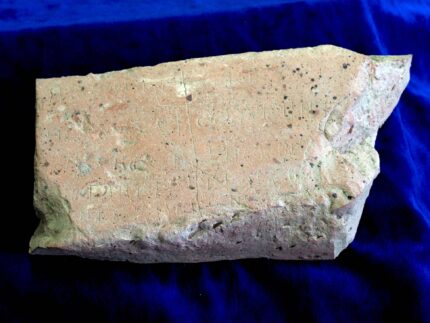Archaeologists have discovered the grave of a clergyman with an inscribed stone “pillow” under his skull at the Tsarevets Fortress in Veliko Tarnovo, Bulgaria. The stone block was engraved with Bible verses in Old Bulgarian and in the middle of them an Orthodox cross, a cross with two horizontal crossbeams, the lower one slanted downwards to the right. There are seven lines quoting the first four verses of the Gospel of John.
Pillow bricks with inscriptions are rare finds in Bulgaria. The closest comparable find was bilingual in Greek and Old Bulgarian, and it was discovered by accident during construction rather than professionally excavated in its original location. Old Bulgarian was used throughout Eastern Europe during the Middle Ages. Also known as Church Slavonic, it was the official language of the Second Bulgarian Empire and is still the official language of several Eastern Orthodox Churches today.
The grave was found in the ruins of a 13th century Holy Mother of God Monastery that was a major religious center when Veliko Tarnovo, then Tarnovgrad, was the capital city of the Second Bulgarian Empire. The remains of the monastery were first discovered in 2014, and the next year’s excavation revealed the ruins of an Early Christian basilica in the same area.
To be buried in this location with funerary furnishings, the clergyman must have been someone of rank, the Father Superior of the monastery at least, and possibly even a Patriarch of the Bulgarian Orthodox Church.
The archaeologist [, Prof. Kazimir Popkonstantinov who helped translate the inscription,] also explains that the brick with the inscription quoting the first four verses of the Gospel of John from Veliko Tarnovo has been found in a grave with an impressive design, featuring arc built into the wall of the 13th century monastery church.
“Most of the graves of senior clergymen have arcs. It features verses 1-4 from the Gospel of St. Apostle John, posing a number of questions with respect the person in the grave. That may have been the death wish of the buried person because almost all interpreters believe that the Gospel of John starts with a foreword containing some main and major Christian truths… The quote indicates that the buried person was a highly erudite man,” Popkonstantinov elaborates.

I had to look up “erudite” and would have liked to see a transcription of the stone cushion from under his skull. The ruins of the “Holy Mother of God Monastery” are southeast of the Fortress in their “Frankish Quarter” at 25° 39′ 21,8″E, 43° 04′ 42,1″N
In 1393, the fortress was besieged by the Turks for three months, before finally being burnt down. On ‘OpenStreetmap’, there is (notably, in Bulgarian!) an “archaeological object” described as: Френкхисар / Frankish средновековен/ Medieval манастир / Monastery, and -of course- I had to look up all of that too.
:hattip:
————-
PS: Nikopol (the city of Victory in 1059 AD) in northern Bulgaria was the site of the “Battle of Nicopolis” in 1396. At the fortress of Nicopolis, the united armies of Christian Europe headed by Hungarian king Sigismund and various French knights were defeated by the Ottomans, cf.: en.wikipedia.org/wiki/Johann_Schiltberger (who was taken as a very young prisoner in that battle, with a few battles to follow).
Yes, indeed, Popkonstantinov elaborates, and possibly embroiders as well.
I assume that the ‘arcs’ are actually ‘arches’, but is it a brick?